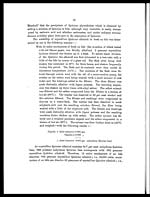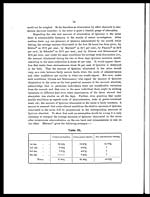Medicine - Institutions > Army health reports and medical documents > Scientific memoirs by officers of the Medical and Sanitary Departments of the Government of India > Number 41 - Quinine and its salts > Quinine and its salts : their solubility and absorbability
(23) Page 13
Download files
Individual page:
Thumbnail gallery: Grid view | List view

13
183 cubic centimetres of ox bile can dissolve one gramme crystalline Quinine
alkaloid. Crystalline Quinine alkaloid is therefore about nine times as soluble
in ox bile as in water. This result differs considerably from that of Giemsa and
Schaumann5 who, using amorphous Quinine alkaloid instead of the crystalline
form used by me, give the amazing solubility of 1 in 83;―i.e., Quinine alkaloid
(amorphous) is twenty times as soluble in ox bile as in water. The amorphous
form would certainly dissolve more quickly than the crystalline, so the solubility
may be under-estimated in my experiments. It is worthy of note also, in this
connection, that the Quinine alkaloid that is precipitated on Quinine salts
coming in contact with alkali in the duodenum must be of the amorphous
variety.
Absorption of Quinine.
Hitherto, experimenters have taken the amount of Quinine eliminated in
the urine as a measure of the amount that has been absorbed and entered the
circulation. It is, therefore, necessary to examine the reliability of this gauge.
Until the beginning of the last decade the views held regarding the elimi-
nation of Quinine appear to have been quite erroneous; there was a lack of
harmony in the results obtained by different investigators not only regarding the
proportion of Quinine eliminated but also regarding the chemical characters of
the Quinine or its derivatives that were eliminated. According to Kerner2
and Merkel19 most of the Quinine was eliminated unchanged in the urine, the
remaining part being excreted in the form of transformed products. Personne,20
however, affirmed that only about half the Quinine administered is eliminated
unchanged in the urine and that the other half is destroyed in the body and not
excreted as transformed products. Schmitz21 and also Giemsa and Schaumann5
have confirmed Personne's observation that only unchanged Quinine is elimi-
nated in the urine; and they maintain that there is no Quinine derivative with
alkaloidal characters present in detectable amount in the urine after Quinine
administration.
Practically speaking, only traces of Quinine are eliminated by channels
other than the kidneys. Mariani13 was able to detect traces in the milk of
nursing mothers and in sweat, in the latter only after the secretion had been
concentrated by evaporation. From the bitter taste experienced for a long
time after taking Quinine in wafers, Giemsa and Schaumann5 are of opinion
that probably a very little is excreted in saliva. In the fæces, under ordinary
circumstances, very little is eliminated: after administration by the mouth,
Kerner2 could find traces only; Merkel19 could find no Quinine; Kleine,22 .3 per
cent. at most; Flamini,23 using the insoluble tannate of Quinine, 8―15 per cent.,
Schmitz21 traces only; and Giemsa and Schaumann,5 even after the adminis-
tration of the insoluble alkaloid itself, traces only―amounts so small that they
D 2
Set display mode to: Large image | Zoom image | Transcription
Images and transcriptions on this page, including medium image downloads, may be used under the Creative Commons Attribution 4.0 International Licence unless otherwise stated. ![]()
| Permanent URL | https://digital.nls.uk/75034223 |
|---|
| Description | Their solubility and absorbability by A.C. MacGilchrist. |
|---|---|
| Shelfmark | IP/QB.10 |
| Additional NLS resources: | |




